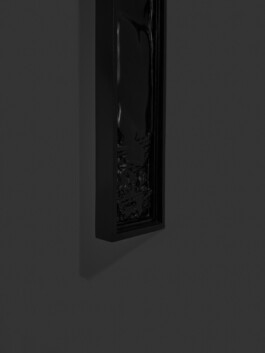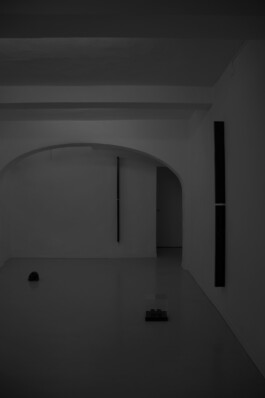
O, DARK DARK DARK _____ 29.03.2025 – 11.05.2025
Spazio DISPLAY, Parma, IT
Black, darkness multiplied, repeated, concentrated. Black is both origin and end, the thin threshold between memory and oblivion. Not merely the absence of light, but the very substance of memory: a substratum where the visible settles and vanishes, leaving behind traces of the past and omens of an imminent future. It is the root and the fate of the visible, the place where form dissolves and reconfigures itself. Sofiia Yesakova and Alessandro Simonini meet within this dialectic, overturning monochrome into polysemy: absolute black is not mere reduction, but a field of tension which questions the relationship between structure and rupture, violence and abstraction. Black demands a searching gaze, a passage through. Both artists share an approach where artistic practice, though yielding distinct results, is deeply intertwined with philosophical thought and informed by anthropological and ecological inquiry.
Sofiia Yesakova crafts sculptures where gesture and perception are suspended between presence and negation, capturing traces of a movement frozen in time. Through a combination of formal rigor and references to the violence of history and sacred and pagan iconography, Yesakova compels the viewer to confront the invisible and the repressed. In her works, black is a paradox: it means erasure, but also memory; silence, yet also a layering of voices waiting to be unraveled. In her austere minimalism, geometry imposes a sterile, unshakable order, confining perception within the margins of form. Yesakova draws on Foucault’s reflections on surveillance and imprisonment, translating them into sculptures where control over her work corresponds to control over the viewer’s sensitivity, forcing them to decipher the tension hidden beneath dark surfaces. In her practice, black accumulates memories that never fully reveal themselves. Only in the layered details does a story begin to emerge—one that Yesakova rewrites like a code etched into wood and buried beneath dense black pigment. This veiled inscription addresses the distance between past and present, tragedy and its reduction to mere statistics. Black, for the artist, is thus both an instrument of organization and obliteration, the echo of unrealized utopias, of historical events translated into numerical data. In this operation, rigor itself comes to resemble an act of violence and coercion: modular and regular forms exclude chaos, yet simultaneously preserve it. The work, like a hypertext, unfolds narratives that demand attentive reading and interpretation.
Alessandro Simonini’s works emerge from in-depth research into iconography and symbolic language, exploring the interaction between matter and transformation, traditional artistic techniques and new technologies. His sculptures are fragments of a personal inquiry into matter, particularly charcoal, which serves both as a symbol and physical substance. Fire and combustion generate the image; his sculptures, conceived as archives of remnants, invite reflection on ephemerality, permanence, and the inevitability of mutation. Like an alchemical and ontological exercise, combustion becomes the means by which destruction is transfigured into creation. Charcoal clings to the image like skin, like memory. Once the residue of organic life, it now endures as a tangible trace. A large frieze with classical echoes depicts the carcass of an ox; zoomorphic heads evoke the gargoyles of Gothic cathedrals. Simonini’s lexicon draws upon architectural and iconographic elements, bringing his work closer to the concept of the monument—celebrating memory, evoking history, and contemplating catastrophe through its ruins. At times, he deliberately damages his own sculptures, only to gather and reassemble the shattered fragments, challenging the very integrity of the work, where destruction and restoration coexist in tension. In this, his works resonate with the contradictions of Timothy Morton’s Dark Ecology, which, in the shadow of the current ecological crisis, reconfigures our daily coexistence with catastrophe. For Simonini, the alternation of aggression and repair represents the core of a poetics in which the fundamental nature of the image lies between conflict and restoration: his works function as palimpsests, where scars, incisions, and transformations generate forces that clash and converge, materializing as marks and traces.
In the works of Simonini and Yesakova, black is a space of tension and crisis, a surface that conceals layers, stratifications, incised and incendiary details. It is the visual articulation of Deleuze’s principle in which repetition is never identical to itself, but always variation, difference, a process in motion. That repetition is never identical to itself, but always a variation, a process in motion. Yesakova examines repetition through the systematization of violence: historical classification, the conversion of tragedy into sequence, the reduction of reality to structure. Simonini, by contrast, engages with repetition through material and its iterations, where uniqueness resides in the fragment. In both cases, black is an accumulation, an entity in becoming which resists full interpretation. It is an act of erasure and a site of renewal, a space where ruin and resurgence intertwine. Black is a premonition, a question, an unresolved tension. O, dark dark dark. They all go into the dark.
Curated by Ilaria Monti
Text by Ilaria Monti on the exhibition O, dark dark dark
Duo exhibition with Alessandro Simonini
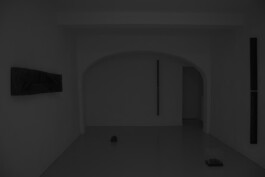
Installation view alongside Alessandro Simonini’s works
In this series of works, I turn to Deleuze’s philosophy of layering, distinction and repetition, vibration and oscillation. Contrasts are an integral part of our history. I draw on the concept of punitive restraint (Foucault) in an attempt to conceal the emotional component, as if severed by anxiety. The awareness of unrealised utopias and thinking in terms of totality are embedded in the details carved into the wooden surface and obscured by black pigment.
I continue to reflect on the recurrence of violence in history and the systems of formalisation, classification, and ordering of events that create a distance between us and the emotional perception of the tragic episodes of our time. For the visual narrative, I turn to religious symbolism, techniques often employed in sacred art, and the cold conventionality of minimalism. The vertical, fragile lines of the monument-like sculptures stand in contrast to the contextualised element. The horizontal, repetitive lines drawn on the “monuments” faintly resemble bureaucratic forms or formal lists extending into infinity—an endless repetition of history’s mistakes that cannot be corrected. Modernity is steeped in anxiety and catastrophising, giving rise to a compulsion to systematise everything.
The aesthetic visualisation of violent scenes across different epochs has served a cathartic function, shaped by eschatological consciousness and collective fears. When confronted with such imagery, we experience a range of emotions that have a “purifying” effect. Clear examples of this can be found in the Renaissance and Baroque periods. Through the tragedy of the individual, the tragedy of the world is revealed, and vice versa. An interest in the interaction between object and space is also evident in the works, where contrasting elements of the installation are placed in dialogue.
Text by Sofiia Yesakova on the series of works Ugly Scenes. Nuances
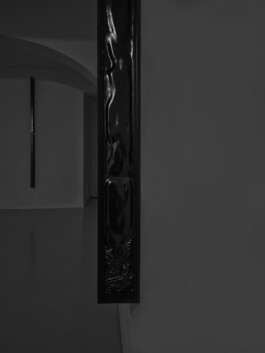
Ugly scenes. Nuances 1.2.-1.3., 190 × 11 × 4 cm (x2), beech wood, gesso, black lacquer, 2025. Close-up
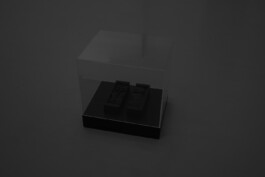
Ugly scenes. Nuances 2.1., 15 × 5 × 3 cm (x2), black wood, linseed oil, beeswax, acrylic glass cube, 2025
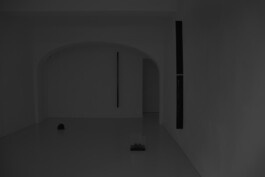
Ugly scenes. Nuances 1.2.-1.3., 190 × 11 × 4 cm (x2), beech wood, gesso, black lacquer, 2025
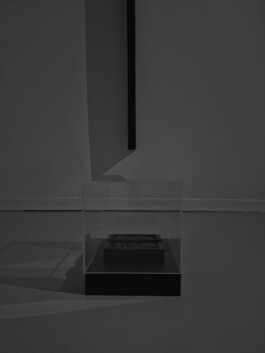
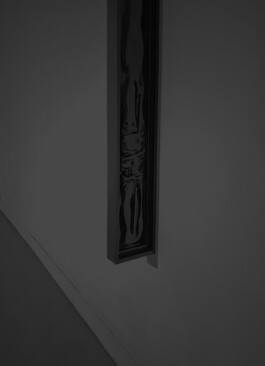

Ugly scenes. Nuances 2.1., 15 × 5 × 3 cm (x2), black wood, linseed oil, beeswax, acrylic glass cube, 2025
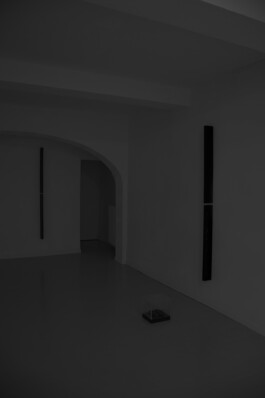
Ugly scenes. Nuances 1.2.-1.3., 190 × 11 × 4 cm (x2), beech wood, gesso, black lacquer, 2025
